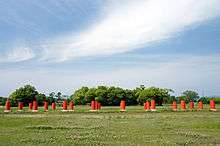Fujiwara-kyō


Fujiwara-kyō (藤原京) was the Imperial capital of Japan for sixteen years, between 694 and 710. It was located in Yamato Province (present-day Kashihara in Nara Prefecture), having been moved from nearby Asuka. However, the name Fujiwara-kyō was never used in the Nihon Shoki. During those times it was recorded as Aramashi-kyō (新益京).
As of 2006, ongoing excavations have revealed construction on the site of Fujiwara-kyō as early as 682, near the end of the reign of Emperor Temmu.[1] With a brief halt upon Emperor Temmu's death, construction resumed under Empress Jitō, who officially moved the capital in 694. Fujiwara-kyō remained the capital for the reigns of Emperor Mommu and Empress Gemmei, but in 710 the Imperial court moved to the Heijō Palace in Nara, beginning the Nara period.
History
Fujiwara was Japan's first capital built in a grid pattern on the Chinese model (条坊制 jōbō-sei); recent investigation has revealed that the city covered an area of roughly 5 km, much larger than previously thought.[1][2] The palace occupied a plot measuring about 1 km², and was surrounded by walls roughly 5 m high. Each of the four walls had three gates; Suzakumon, the main gate, stood at the center of the south wall. The Daigokuden (大極殿) and other palace buildings were the first palace structures in Japan to have a tile roof in the Chinese style.
The area had previously been the domain of the Nakatomi clan, who oversaw the observation of Shintō rituals and ceremonies on behalf of the Imperial court. The city burnt down in 711, one year after the move to Nara, and was not rebuilt. Archaeological excavations began in 1934, and some portions of the palace were reconstructed. Close to 10,000 wooden tablets, known as mokkan, have been found, inscribed with Chinese characters.
This waka, written by the Empress Jitō, and describing Fujiwara in the summer, is part of the famous poem anthology, the Hyakunin Isshu:
| “ | 春すぎて夏来にけらし白妙の衣ほすてふ天の香具山
haru sugite natsu ki ni kerashi shirotae no koromo hosu chō ama no kaguyama |
” |
Which translates[3] as Spring has passed, it seems, and now summer has arrived; For this, they say, is when robes of pure white are aired on heavenly Mount Kagu.
See also
References
- Frederic, Louis (2002). "Japan Encyclopedia." Cambridge, Massachusetts: Harvard University Press.
- 1 2 "Nara". National Research Institute for Cultural Properties. Retrieved 2007-03-10.
- ↑ 藤原京ルネッサンス (in Japanese). Retrieved 2007-03-10.
- ↑ "One Hundred Poems by One Hundred Poets (Ogura Hyakunin Isshu), poems 1-5". Archived from the original on 2011-07-22. Retrieved 2010-08-02.
External links
![]() Media related to Fujiwara-kyō at Wikimedia Commons
Media related to Fujiwara-kyō at Wikimedia Commons
| Preceded by Asuka-kyō |
Capital of Japan 694–710 |
Succeeded by Heijō-kyō |
Coordinates: 34°30′08″N 135°48′26″E / 34.50222°N 135.80722°E